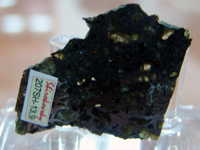Shirokovsky
This fabulous new pallasite fell on 1 Feb 1956. It was observed by numerous eyewitnesses and window glass in some villages were broken by the impact wave. The meteorite fell in the Shirokovsky water reservoir, on the Kosva River near Shirokovsky village. The meteorite fell through the ice making a 42 cm diameter hole in the 80 cm thick ice sheet. Magnetic particles enriched in Ni were extracted from the ice surrounded the hole. 46 years later divers were able to recover a number of pieces totaling 150kg. It is classified as an anomalous pallasite with a nickel content of 35.6%. These pieces are cut an incredible 1mm thick. Super surface area for the weights.
Russia, Perm district
Fell 1956, February 1, 3:30 UT, found 2002.
Pallasite anom
A fireball shining brighter than the Sun and leaving a smoke trail was observed by numerous eyewitnesses in an area of about 500 km2. The fireball disappeared in 5-6 seconds but the trail was visible for an hour. A powerful explosion caused a weak earthquake. Windows in nearby villages were broken by the impact wave. The meteorite fell on the frozen Shirokovsky reservoir situated on the Kosva River near Shirokovsky village and the cities of Ugle-Uralsk and Kizel. The meteorite made a 42 cm diameter hole in the 80 cm thick ice sheet and sank to the bottom at a depth of 23 m. Magnetic particles enriched in Ni were extracted from the ice surrounding the hole.
Several attempts by divers to recover the meteorite on the bottom were not successful. In early 2002, anonymous researchers found the meteorite after 3 years of searching. Many fragments of about 150 kg in total were found.
Apparently the main meteorite body was destroyed during the collision.
Classification and mineralogy (S. Afanasiev, Vernad Inst),
Analyzes (M.Nazarov, N.Kononkova, G.Kolesov, Vernad Inst):
olivine, Fa11.6;
bulk metal, Co=2.4 %, Ni = 35.6 %;
Ga = ** ppm, Ge = ** ppm;
Ir = 4.3 ppb, Os = 3.8 ppb, Au = 540 ppb, Ag = 2700 ppb, Pt = 339 ppb, Ru = 40 ppb.
Specimens: ** g,
Vernad; main mass with anonymous finder.
Shirokovsky
Information about the name
Name: Shirokovsky
This is NOT an official name: Pseudo meteorite.
There is no official abbreviation for this meteorite.
Year found: 2002
Class: Pseudometeorite
Country: Russia
Coordinates: 58° 48'N, 57° 57'E
References: Never published in the Meteoritical Bulletin Find references in NASA ADS
Comments: Published on MetBull website
Mass: 150 kg
“Shirokovsky pallasite”, special statement.
Specimens of an object known as the “Shirokovsky pallasite,” recently acquired by a variety of public and private collections, are probably not meteorites. The petrology and geochemistry of this object strongly suggest that it has a terrestrial origin. Below is an account of the 1956 bolide that may have produced meteorites (still undiscovered), followed by a description of the probable pseudometeorite.
At 03:30 UT on 1956 Feb 1, a fireball shining brighter than the sun and leaving a smoke trail was observed by numerous eyewitnesses in an area of about 500 km2 across Russia. The fireball disappeared in 5-6 seconds but the trail was visible for an hour. Windows in nearby villages were broken by the shock wave. A meteorite reportedly fell on the frozen Shirokovsky reservoir (58°48'N, 57°57'E), situated on the Kosva River near Shirokovsky village and the cities of Ugle-Uralsk and Kizel, Producing a 42-cm diameter hole in 80-cm thick ice. Magnetic particles enriched in Ni were extracted from the ice surrounding the hole. Several attempts by divers to recover the meteorite on the bottom were not successful. In early 2002, anonymous searchers found many fragments, totaling ~150 kg, of iron-rich material at the site.
Mineralogy and petrography (M. A. Nazarov, Vernadsky Inst., L. A. Taylor, University of Tennessee): The material is breccia-textured, with angular silicate clasts in a metal-rich matrix. Clasts consist mainly of olivine fragments up to 1 cm (Fa3-39, avg = Fa12, CaO up to 1 wt%, NiO up to 0.3 wt%, Fe/Mn = 8-34 at., avg = 21) and rare diopside grains (Fs3-19Wo43-50). Olivine contains small inclusions of diopside, roedderite (?), Mg-rich wustite and magnesioferrite. There is no reaction zone between olivine fragments and the metallic matrix, however diopside has reacted with the matrix to produce unknown Ca,Fe,Mg-rich phases, larnite and merwinite. The matrix is metal-wustite eutectic containing minor Ca-rich fayalite. The metal contains 20-47 wt% Ni (avg = 26.5) and 0.8-2.2 wt% Co (avg = 1.3). Phosphorus and Cu were not detected. Sulfides, phosphides, phosphates, chromite, and Al-bearing phases were not found.
Superficially, the mineralogy resembles that of pallasites, and the Fa number and Fe/Mn ratio of the olivine are comparable to those of pallasite olivines. However the high Ni of the olivine is distinct from that in all metal-rich meteorites. The metal-wustite eutectic has never been documented in meteorites. Accessory minerals are atypical of meteorites, and accessory phases typical of stony-iron meteorites are absent. Olivine chemistry (Fa, Fe/Mn, CaO, NiO) resembles that in some terrestrial carbonatites. Olivine was not equilibrated with the matrix melt, which crystallized quickly under highly oxidizing conditions.
Mineralogy and petrography (T. Bunch and J. Wittke, Northern Arizona Univ.): contains subequal proportions of fragmental olivine and metal-rich matrix. Olivine cores average Fa11.4, rims Fa17, and have lower Fe/Mn than pallasites. Olivine has inclusions of ferroan magnesioferrite (5-80 µm), magnesiowustite (Mg0.7Fe0.3), and an alkali-rich Ca phosphate (<30 µm). Metal composition (wt%), Ni = 23.6, Co = 1.8, Mn = 0.12, Ti = 0.11, Cr = 0.25. Metal contains vermicular inclusions of magnesian magnetite (4-8 vol%), magnesian kirschteinite (4-8 vol%), and rare chromite, plagioclase (An89), and olivine (Fa41).
Instrumental neutron activation analysis (M.A. Nazarov and G.M. Kolesov, Vernadsky Inst.): Composition of metal-wustite eutectic, Ni =14 wt%, Co = 1.03 wt%, Au = 540 ppb, Ag = 2700 ppb, Pt = 339 ppb, Os = 3.8 ppb, Ir = 4.3 ppb, and Ru = 40 ppb. The Ni and Co contents are similar to those in some pallasites. The Au, Ir and Os concentrations are all significantly lower than those in pallasites. Pt/Ir is 40× the solar ratio, similar to that of Cu-Ni ore deposits.
Oxygen isotopes (D. Rumble III, Carnegie Inst. Wash.): Olivine of the Shirokovsky specimen is on the terrestrial oxygen isotope fractionation line, δ17O = +2.44‰, δ18O = +4.63‰, ∆17Ο = +0.002.
Noble gases (Yu. A. Shukolyukov and L. Schultz, Max-Plank Inst.): olivine has 20Ne/22Ne = 7.4 and 21Ne/22Ne = 0.038, close to the ratios of planetary gas. No cosmic component was found in He, Ne, or Ar isotopic compositions. This suggests that the specimen has never been in space, it came from the interior of a large meteoroid, or it had a very short cosmic exposure history. The small size of the hole in the reservoir ice and the lack of other meteorite fragments indicate that the pre-atmospheric mass was on the order of 1 m in diameter, too small to lack cosmic noble gases. Very short cosmic exposure histories are not typically observed in meteorites. Some radiogenic 40Ar is present; if the K content of the olivine is similar to that of Omolon olivine (8 ppm), then the K-Ar age of the Shirokovsky sample would be about 270 Ma.
Nuclear tracks (L.L. Kashkarov, Vernadsky Inst.): Cosmic-ray tracks, common in pallasite olivine grains, were not found in olivine from the Shirokovsky specimen. This is consistent with the results of the noble gas studies. Fission tracks are possibly present.
Thermoluminescence studies (A.I. Ivliev, Vernadsky Inst.) Induced TL spectra of olivine are similar to those of olivine of terrestrial peridotites in having a strong peak at 125oC and a smaller one at 275oC. Pallasite olivine from Marjalahti is completely different, with a strong peak at 240oC and a weaker one at 160oC.
석철운석 Shirokovsky Pallasite (해외배송 가능상품)
| 상품명 | 석철운석 Shirokovsky Pallasite |
|---|---|
| 제조사 | 자체제작 |
| 원산지 | 러시아(Russia) |
| 판매가 | Reservation |
| 상품코드 | P0000LUR |
| 수량 |   |

(최소주문수량 1개 이상 / 최대주문수량 0개 이하)







































 수량을 선택해주세요.
수량을 선택해주세요.





































